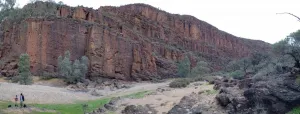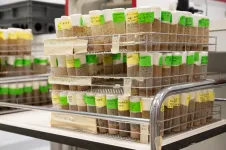Changes in Earth's orbit enabled the emergence of complex life
2021-07-07
(Press-News.org) Scientists at the University of Southampton have discovered that changes in Earth's orbit may have allowed complex life to emerge and thrive during the most hostile climate episode the planet has ever experienced.
The researchers - working with colleagues in the Chinese Academy of Sciences, Curtin University, University of Hong Kong, and the University of Tübingen - studied a succession of rocks laid down when most of Earth's surface was covered in ice during a severe glaciation, dubbed 'Snowball Earth', that lasted over 50 million years. Their findings are published in the journal Nature Communications.
"One of the most fundamental challenges to the Snowball Earth theory is that life seems to have survived," says Dr Thomas Gernon, Associate Professor in Earth Science at the University of Southampton, and co-author of the study. "So, either it didn't happen, or life somehow avoided a bottleneck during the severe glaciation."
The research team ventured into the South Australian outback where they targeted kilometre-thick units of glacial rocks formed about 700 million years ago. At this time, Australia was located closer to the equator, known today for its tropical climates. The rocks they studied, however, show unequivocal evidence that ice sheets extended as far as the equator at this time, providing compelling evidence that Earth was completely covered in an icy shell.
The team focused their attention on "Banded Iron Formations", sedimentary rocks consisting of alternating layers of iron-rich and silica-rich material. These rocks were deposited in the ice-covered ocean near colossal ice sheets.
During the snowball glaciation, the frozen ocean would have been entirely cut off from the atmosphere. Without the normal exchange between the sea and air, many variations in climate that normally occur simply wouldn't have.
"This was called the 'sedimentary challenge' to the Snowball hypothesis," says Professor Ross Mitchell, professor at the Chinese Academy of Sciences in Beijing, China and the lead author. "The highly variable rock layers appeared to show cycles that looked a lot like climate cycles associated with the advance and retreat of ice sheets." Such variability was thought to be at odds with a static Snowball Earth entombing the whole ocean in ice.
"The iron comes from hydrothermal vents on the seafloor," added Gernon. "Normally, the atmosphere oxidizes any iron immediately, so Banded Iron Formations typically do not accumulate. But during the Snowball, with the ocean cut off from the air, iron was able to accumulate enough for them to form."
Using magnetic susceptibility - a measure of the extent to which the rocks become magnetised when exposed to a magnetic field - the team made the discovery that the layered rock archives preserve evidence for nearly all orbital cycles.
Earth's orbit around the sun changes its shape and the tilt and wobble of Earth's spin axis also undergo cyclic changes. These astronomical cycles change the amount of incoming solar radiation that reaches Earth's surface and, in doing so, they control climate.
"Even though Earth's climate system behaved very differently during the Snowball, Earth's orbital variations would have been blissfully unaware and just continued to do their thing," explains Professor Mitchell.
The researchers concluded that changes in Earth's orbit allowed the waxing and waning of ice sheets, enabling periodic ice-free regions to develop on snowball Earth.
Professor Mitchell explained, "This finding resolves one of the major contentions with the snowball Earth hypothesis: the long-standing observation of significant sedimentary variability during the snowball Earth glaciations appeared at odds with such an extreme reduction of the hydrological cycle".
The team's results help explain the enigmatic presence of sedimentary rocks of this age that show evidence for flowing water at Earth's surface when this water should have been locked up in ice sheets. Dr. Gernon states: "This observation is important, because complex multicellular life is now known to have originated during this period of climate crisis, but previously we could not explain why".
"Our study points to the existence of ice-free 'oases' in the snowball ocean that provided a sanctuary for animal life to survive arguably the most extreme climate event in Earth history," Dr Gernon concluded.
INFORMATION:
[Attachments] See images for this press release:

ELSE PRESS RELEASES FROM THIS DATE:
2021-07-07
By combining two distinct approaches into an integrated workflow, Singapore University of Technology and Design (SUTD) researchers have developed a novel automated process for designing and fabricating customised soft robots. Their method, published in Advanced Materials Technologies, can be applied to other kinds of soft robots--allowing their mechanical properties to be tailored in an accessible manner.
Though robots are often depicted as stiff, metallic structures, an emerging class of pliable machines known as soft robots is rapidly gaining traction. ...
2021-07-07
Despite having been formalized as a species in 1936, Wolbachia pipientis remains an elusive microbe. The reason why relates to the relationship it establishes with its hosts. Wolbachia lives inside the cells of 40% of the arthropods, in their majority insects, intertwined in a symbiosis so complex that it can no longer survive on its own. "Guessing what it takes to grow and manipulate it outside the host might not be possible", says Luís Teixeira, IGC principal investigator. And, so far, despite countless attempts, no one has succeeded in culturing this bacterium or modifying its genetic sequence.
Before joining the team led by Luís Teixeira, Elves Duarte was interested in studying the symbiosis between ...
2021-07-07
East Hanover, NJ. July 7, 2021. A team of researchers identified nine meaningful reasons that prevent people with disabilities from seeking employment. Their findings provide a much-needed understanding of this population's motives for remaining unemployed, which can inform programs and policies that promote labor force participation of people with disabilities. The article, "Understanding Persons with Disabilities' Reasons for Not Seeking Employment" (doi: 10.1177/00343552211006773) was published in Rehabilitation Counseling Bulletin on April 15, 2021.
The authors are Denise C. Fyffe, PhD, Anthony H. Lequerica, PhD, and John O'Neill, PhD, of Kessler Foundation; Courtney Ward-Sutton, PhD, and Natalie F. Williams, PhD, of Langston University; and Vidya Sundar, OT, PhD, ...
2021-07-07
Palo Alto, CA--Dehydrated plant seeds can lay dormant for long periods--over 1,000 years in some species--before the availability of water can trigger germination. This protects the embryonic plant inside from a variety of environmental stresses until conditions are favorable for growth and survival. However, the mechanism by which the baby plant senses water and reactivates cellular activity has remained a mystery until now.
New work jointly led by Carnegie's Yanniv Dorone and Sue Rhee and Stanford University's Steven Boeynaems and Aaron Gitler discovered a protein that plays a critical "go, or no-go" role in this process--halting germination if the soil's hydrological conditions are ...
2021-07-07
The principle that form follows function does not only apply to design and architecture. It also applies to biology. Every organism is a universe that lives thanks to the activities of tens of thousands of nanomachines, whose functions depend on their forms. Biologists say macromolecular complexes instead of nanomachines and structure instead of form, but the idea is the same: know the form and you will understand the function. Now, a group at the Spanish National Cancer Research Centre (CNIO) has helped determine the structure of a nanomachine essential for the functioning of another, mTOR, which plays fundamental roles in ...
2021-07-07
A team led by researchers from Queen Mary University of London has developed a new artificial intelligence (AI) tool that is able to automatically measure the amount of fat around the heart from MRI scan images.
Using the new tool, the team was able to show that a larger amount of fat around the heart is associated with significantly greater odds of diabetes, independent of a person's age, sex, and body mass index.
The research is published in the journal Frontiers in Cardiovascular Medicine and is the result of funding from the CAP-AI programme, which is led by Barts Life Sciences, a research and innovation partnership between Queen Mary University of London and Barts Health NHS Trust.
The distribution of fat in the body can influence a person's ...
2021-07-07
Many people instinctively associate mucus with something disgusting, but in fact, it has incredibly many valuable functions for our health. It keeps track of our important intestinal flora and feeds the bacteria. It covers all internal surfaces of our body, and, as a barrier to the outside world, it helps us protect ourselves from infectious diseases.
This is because mucus acts as a filter that keeps the bacteria in or out, and the bacteria feed on the sugars in the mucus between meals. So, if we can produce the mucus that is already present in the body with the right sugars, it might be used in brand new medical treatments.
Now, researchers from the DNRF Centre ...
2021-07-07
Physicists of Ruhr-Universität Bochum (RUB) have taken spectacular pictures that allow the ignition process of plasma under water to be viewed and tracked in real time. Dr. Katharina Grosse has provided the first data sets with ultra-high temporal resolution, supporting a new hypothesis on the ignition of these plasmas: In the nanosecond range, there is not enough time to form a gas environment. Electrons generated by field effects lead to the propagation of the plasma. The nanosecond plasma ignites directly in the liquid, regardless of the polarity of the voltage. The report from the Collaborative Research Centre 1316 "Transient Atmospheric Pressure Plasmas: from Plasma to Liquids to Solids" has been published in the Journal of Applied Physics and Rubin, the ...
2021-07-07
COLUMBUS, Ohio - Female vampire bats establish an egalitarian community within a roost rather than a society based on a clear hierarchy of dominance that is often seen in animal groups, a new study suggests.
Researchers observed more than 1,000 competitions for food among a colony of 33 adult female bats and juveniles living in captivity, assigning a rank to each bat based on a calculation of wins and losses in those contests.
The team found that, unlike in many mammal societies, the higher-ranking animal didn't necessarily win every bout over food, and there was a randomness to the ranking order - no specific quality they measured gave a bat a better chance at dominance, so any adult female had an equal opportunity to rank very high or very low on a scale of ...
2021-07-07
Environmental education provision needs greater investment and innovation if future generations are to be able to respond fully to the climate emergency, experts have said.
The deepening environmental crisis will continue to worsen if there is not significant support and investment in environmental and science education, researchers have warned. Reforms would help young people to address the complex, interlinked and dynamic issues of our contemporary situation.
The experts argue Governments and other organisations must direct more funding to education innovation in response to consistent warnings from scientists about trends in the deteriorating state of ecosystems, biodiversity and climate, amongst other environmental issues.
Writing in Environmental Education ...
LAST 30 PRESS RELEASES:
[Press-News.org] Changes in Earth's orbit enabled the emergence of complex life



